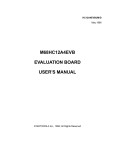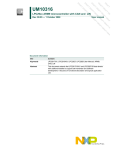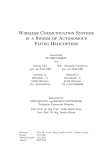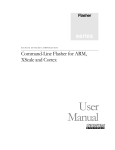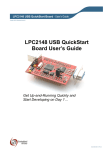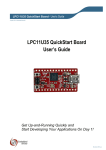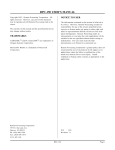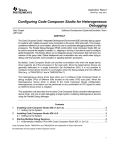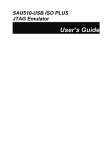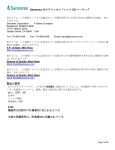Download User Guide - Signum Systems Corp.
Transcript
Chameleon series SIGNUM SYSTEMS CORPORATION Flash Programming Plugin for Chameleon Debugger User Guide COPYRIGHT NOTICE Copyright (c) 2007 by Signum Systems Corporation. All rights are reserved worldwide. No part of this publication may be reproduced, transmitted, transcribed, stored in a retrieval system, or translated into any language or computer language, in any form or by any means, electronic, mechanical, magnetic, optical, chemical, manual, or otherwise, without the prior written permission of Signum Systems. DISCLAIMER Signum Systems makes no representations or warranties with respect to the contents hereof and specifically disclaims any implied warranties of merchantability or fitness for any particular purpose. Also, Signum Systems reserves the right to revise this publication and to make changes from time to time in the content hereof without obligation of Signum Systems to notify any person or organization of such revision or changes. WARRANTY Signum Systems warrants to the original purchaser that this product is free of defects in material and workmanship and performs to applicable published Signum Systems specifications for a period of SIX MONTHS from the date of shipment. If defective, the product must be returned to Signum Systems, prepaid, within the warranty period, and it will be repaired or replaced (at our option) at no charge. Equipment or parts which have been subject to misuse, abuse, alteration, neglect, accident, unauthorized installation or repair are not covered by warranty. This warranty is in lieu of any other warranty expressed or implied. IN NO EVENT SHALL SIGNUM SYSTEMS BE LIABLE FOR CONSEQUENTIAL DAMAGES OF ANY KIND. It is up to the purchaser to determine the reliability and suitability of this product for his particular application. 1211 FLYNN RD., UNIT #104 CAMARILLO, CA 93012, U.S.A PHONE 805 • 383 • 3682 W W W . S I G N U M . C O M UG-C-Cham-FlashProgPlugin 7.19.04.10.27 410 Chameleon series Purpose This document explains how to use the flash programming utility built into the Signum Systems Chameleon Debugger software. Installation Chameleon Debugger is furnished with a flash programming plug-in. This plug-in is installed by default, but can be uninstalled or reinstalled at any time if necessary. For details, please refer to Chameleon User Manual. Flash Programming Processes The process of programming flash using the plug-in programmer consists of two phases: • configuring (setting the parameters of) the plug-in and • executing proper plug-in commands. ! To program the flash memory on your target system: by selecting the Flash Programmer option from the Tools menu. The Flash Programming dialog box appears (Figure 1). Open the Flash Programmer plug-in dialog 1 SI GNUM S YS TE M 4 1 0 FIGURE 1 Running the flash programmer. Configuring the Plug-In Before it can program flash memory, the programmer needs to be configured. The first and critical step in setting the necessary programmer parameters is selecting the appropriate flash device. ! To choose the flash device 1. Choose the flash device programmer and set its parameters tab (Figure 2). 2 in the Flash Device FL AS H P ROGR AM M I NG PLUG IN FOR C H AM EL EO N DEBUG GER U S E R G U I D E FIGURE 2 Setting up the flash device and its programmer. 2. from the Flash Device drop-down list. A programmer file associated with the current flash device appears in the Programmer drop-down list. Use the Custom option (at the bottom of the Flash Device list) to add new devices. Select the flash device 3 SI GNUM S YS TE M 4 1 0 3. If you are using a Custom device, select the Programmer file from the Programmer drop-down list, or navigate to that file using the browse button on the right. 4. Set the programmer parameters. Refer to your programmer’s documentation for a description of the programmer options. PARAMETER Base Address RAM Address Erase Watchdog 4 DESCRIPTION The start memory address of the flash. Passes to the programmer the -b<base_addr> option. If the RAM Address field is enabled for editing, enter the address of the RAM accessible to the plug-in. The minimum amount of memory required is usually specified in the Flash Device description. For instance, the “CFI 16-bit flash programmer (fits 64K RAM).” Flash erase control. • Chip – erases the entire flash device. • Range – erases all sectors containing the specified range. Eg., to erase one sector at 0x100_0000, the range can be set to 0x100_0000-0x100_0000. Passes to the programmer the -e<addr>-<addr> option. • Auto – erases all sectors in the address range calculated from the image file specified in the Image Name text box (Figure 4). A sequence of operations of writing to the watchdog register that “kicks the dog.” • Address – watchdog register address. • Value Sequence – coma-separated list of values to be written to the watchdog register to “kick the dog.” Passes to the programmer the -w<addr>:<value1>,<addr>:<value2>, … FL AS H P ROGR AM M I NG PLUG IN FOR C H AM EL EO N DEBUG GER U S E R PARAMETER Startup/ Cleanup Macros Verbose Options G U I D E DESCRIPTION option. The startup macro prepares the processor for flash programming. This usually consists in configuring the flash and RAM memories where the programmer is to be loaded, disabling interrupts as well as enabling and configuring semi-hosting. The cleanup macro can be used to reverse the changes made by the startup macro. A subroutine in the target startup macro can be used instead of a macro file when preceded by the @ character: @yourSubroutineName. Generates extended debugging information from the programmer for troubleshooting purposes. Passes to the programmer the –v option. Text field for entering special purpose programmer options not found on the Flash Device tab. As of this writing, the following options are supported: • -f<clk> – System clock frequency. ! CCLK in kHz for the Philips LPC2xxx programmer. ! HCLK in MHz for the TI TMS570 internal flash programmer. • -p<mode> – Flash device dependent option. For: ! Mitsubishi flash devices used by the CFI programmers—sets the value of the protection pin (0 or 1). ! Philips LPC2xxx/LPC17xx internal flash—If <mode> is greater than zero, the programmer calculates and programs a valid User Program Signature at the reserved ARM interrupt vector location (0x14 in 5 SI GNUM S YS TE M 4 1 0 • • • • 6 LPC2xxx or 0x1C in LPC17xx). – Forces device identification. Use when the device cannot be identified uniquely. ! TI TMS470R1 internal flash programmer—Use when the DEV[11...0] register does not uniquely identify your device. Example: -iTMS470R1A256. ! ST Microelectronics STR71x internal flash programmer – Used obligatorily. Requires a complete part number (-iSTR712FR2T6) or flash type code (-i0 stands for 64K flash, -i1 for 128K flash, and –i2 for 256K flash). ! Philips LPC2xxx/LPC17xx internal flash programmer – Use when the programmer does not recognize the device automatically. Example: -iLPC2212 or –iLPC1751. ! Analog Devices ADuC70xx internal flash programmer – Use to specify the silicon revision (F to Z). Forces the use of the mass-erase flash function to erase the entire chip. Without it, the chip is erased sector-by-sector. (Note that silicon versions earlier than F do not support the mass erase functionality.) -c<mode> – Used to check or calculate parity or ECC bits. Available modes: ! -ceven – even parity bits used. ! -codd – odd parity bits used. ! -cecc – ECC code used. -ma<mask> – Command address mask for the CFI programmer. Example: -ma0x7FF -md<mask> – Command data mask for the CFI programmer. Example: -md0xFF -i<device name> FL AS H P ROGR AM M I NG PLUG IN FOR C H AM EL EO N DEBUG GER U S E R G U I D E Options for the internal flash F05 in the TI TMS470R1x devices—recommended for production purposes only. • -k<key0>,<key1>,<key2>,<key3> – Level 2 security key used to unlock the Flash for writing. The key is required if the flash has been protected with values other then all Fs. If trailing keys are omitted, the last specified key is used (at least one key is required). Example: -k0x11223344,0x55667788 is equal to -k0x11223344,0x55667788,0x55667788,0x556677 88. • -knew<key0>,<key1>,<key2>,<key3> – New level 2 security key to be set after programming. Written to the device as a new security key. View the Log tab to verify the new keys. • -kcode – New level 2 security key taken from the code at address 0x1FF0-0x1FFF. For example, “-f17400 –p1” in the Options field would pass the programmer a clock frequency of 17.4 MHz and instruct it to update the code signature at address 0x14. Query Device Button for querying the type of the memory device at the base address. • If a Common Flash Interface (CFI) compliant flash device is found, the size of the flash, the number and sizes of the sectors, and the programmer-recommended name are displayed. (The flash log files described in the Flash Programming Log section provide more information about the device). The Memory Device 7 SI GNUM S YS TE M 4 1 0 Information dialog box appears, allowing you to set selected parameters to the values returned by the query (Figure 3). • If a non-CFI compliant device or RAM is found, a message informing you that ROM or RAM, respectively, has been found appears. FIGURE 3 Flash query using the Query Device button. The results can be used to configure the programmer automatically. Flash Erasing, Programming and Verification ! To program the flash, verify the programming, or erase the flash 1. Set up the flash programming parameters in the Flash Image tab. Choose the image file type in the File Type drop-down list box. Then enter the flash image file name in the Image Name box, or browse for the file. You may need to enter the loading address offset in the Address Offset text box. This offset specifies the loading address for binary files or the offset added to the loading addresses in HEX, SREC and linker output files. 8 FL AS H P ROGR AM M I NG PLUG IN FOR C H AM EL EO N DEBUG GER U S E R G U I D E FIGURE 4 Selecting the flash image parameters and programming operations. 2. This step depends on the intended operation. Some of these operations may require selecting additional options before you press the appropriate operation button. Program, Verify, Erase or Abort. Select the Close After Programming option to close the flash programming plug-in after successful programming or erasing. PROGRAM BUTTON Normally, programming the flash device requires earlier erasing the flash memory. Also, it is advisable that you verify the contents of the programmed flash. These two operations are controlled by the following options: Erase Before Programming Instructs the programmer to erase the entire flash memory prior to uploading data to the device when the Program button is pressed. When uploading multiple files to the flash, 9 SI GNUM S YS TE M 4 1 0 deselect Erase Before Programming, and use the Erase button to clear the entire flash only before programming the first file. Verify While Programming Instructs the programmer to perform its own programming verification. (This verification is not to be confused with the verification triggered by the Verify button, which is performed by the flash programming plug-in. See the VERIFY BUTTON section further in the text.) Finally, press the Program button. Flash programming commences and the Status text box starts displaying progress report messages. 10 FL AS H P ROGR AM M I NG PLUG IN FOR C H AM EL EO N DEBUG GER U S E R G U I D E FIGURE 5 Programming operation under way. The status is displayed at the top of the dialog box. VERIFY BUTTON The Verify button is used to compare the data in a flash image file with the data read from the flash memory. (Please make sure that the Image Name and Address Offset are set appropriately before you press the Verify button.) Since this verification is performed by the plug-in, and not by the programmer, the Flash Device does not need to be specified. Verification performed using the Verify button is possible only if the entire flash memory to be verified can be read by the plug-in. ERASE BUTTON This button clears the entire flash memory. Make sure that the currently selected flash device is the same as the one used for programming. No other parameter is required. 11 SI GNUM S YS TE M 4 1 0 ABORT BUTTON To terminate the programming, verification or erasing operation, press the Abort button. Note: Some flash devices do not allow the erase process to be interrupted. Utility Functions The flash programming plug-in provides two functions frequently used in connection with flash programming: Save and Blank Check. To execute these functions, select the Utilities tab. FIGURE 6 The handy Save and Blank Check functions are accessible via the Utilities tab. SAVE The Save function saves the flash memory within a given address range in a binary data file. It is equivalent to the debugger’s SAVE BIN command. Recall that debugger commands can be executed in the Chameleon Command window. Since the Save function is not limited to flash memory only, you can use it to store 12 FL AS H P ROGR AM M I NG PLUG IN FOR C H AM EL EO N DEBUG GER U S E R G U I D E memory blocks of any type. The Save function does not depend on any of the parameters set in the Flash Image or Flash Device tabs. ! To save a memory range to a file 1. Enter the memory range start and end addresses in the From and To text boxes, respectively. 2. Press the Save button. A file open dialog box appears. 3. Enter the file name, or browse for the binary file, in which the memory range data is to be saved. BLANK CHECK The Blank Check function is used to check if all the bits in the specified memory range are set to 1s. As flash memory is erased by setting its bits to 1s, the function verifies that the flash has been erased. The Blank Check function does not depend on any of the parameters set in tabs the Flash Image or Flash Device tabs. ! To verify that a memory range has been erased 1. Select the desired memory address range in the Address Range group. 2. Press the Blank Check button. Flash Programming Log The flash programming plug-in creates a log of flash programming activity. You can control the amount and type of information stored, save, copy and clear the log using the controls found in the Log tab. 13 SI GNUM S YS TE M 4 1 0 FIGURE 7 The flash programming log window. LOG LEVEL The log content can be filtered in several ways. Use the Log Level drop-down list to select the filtering criteria that fit your needs best. The available levels are listed below in increasing order of comprehensiveness. Errors Only The log records only error messages. Normal In addition to Errors Only level messages, the log records commands (Erase, Program, Save, Bank Check, etc.) along with their parameters. 14 FL AS H P ROGR AM M I NG PLUG IN FOR C H AM EL EO N DEBUG GER U S E R User's Log G U I D E In addition to Normal level messages, the log records messages from the programmer execution on the target board. The programmer’s messages are prefixed by the target name. For example, a message from the STapollo target may look like this: “STapollo: Erasing the flash . . .” In addition to User’s Log level messages, the log records requests from the programmer code to the flash programming plugin, with the exception of those relating to flash image data. Calls Except Data Access All Calls In addition to Calls Except Data Access level messages, the log records those requests from the programmer to the plug-in that relate to the flash image. All Calls and Data In addition to All Calls level messages, the log records the flash image data passed from the plug-in to the programmer. The Normal log level is designed to help you keep track of the performed operation, allowing you to verify the data used to program the flash, destination addresses, and the like. The User’s Log and higher levels are designed to troubleshoot the programming process or debug the programmer code. These levels degrade programming performance considerably, and therefore are not recommended to be used routinely. SAVE ! To save the current log 1. Click the Save button. The Save As dialog appears. 2. Enter the name of the log file, or browse for the existing file. 3. Press OK to save the log to the file. 15 SI GNUM S YS TE M 4 1 0 COPY TO CLIPBOARD The Copy To Clipboard button copies the entire current log to the MS Windows clipboard. CLEAR The Clear button erases the current log from the flash programming log window. Flash Programming using Macros Setting Plug-In Parameters for Flash Programming with Macros Perhaps the easiest way to create a macro that configures the plug-in is to set the parameters via the plug-in GUI interface, as described earlier in the Configuring the Plug-In section, and then to save the configuration commands to a file by pressing the Save Config button (Figure 2). Plug-in Configuration Macrofile Example plugin paramset FlashImage.EraseBeforeProgramming=1 plugin paramset FlashImage.VerifyWhileProgramming=1 plugin paramset FlashImage.AddressOffset=0 plugin paramset FlashImage.FileType=0 plugin paramset FlashImage.ImageName="D:\Alpha\AT91EB40A\Flash\demo.elf" plugin paramset FlashDevice.FlashDevice="LPC2xxx internal flash programmer" plugin paramset FlashDevice.Programmer="D:\Chameleon\Plugin\Flash\ARM\LPC2xx x\LPC2xxx.elf" plugin paramset FlashDevice.StartupMacro="D:\ Chameleon \Arm\TestFlashStartup.mac" plugin paramset FlashDevice.CleanupMacro="D:\ Chameleon \Arm\TestFlashCleanup.mac" plugin paramset FlashDevice.Options="-f17400" plugin paramset FlashDevice.BaseAddress="0x100_0000" plugin paramset FlashDevice.Erase.From="0x100_0000" plugin paramset FlashDevice.Erase.To="0x11F_FFFF" 16 FL AS H P ROGR AM M I NG PLUG IN FOR C H AM EL EO N DEBUG GER U S E R G U I D E plugin paramset FlashDevice.Watchdog.Address="0x8001_00C0" plugin paramset FlashDevice.Watchdog.ValueSequence="1,0" plugin paramset FlashDevice.Verbose=1 plugin paramset FlashDevice.Erase.Chip=0 plugin paramset FlashDevice.Erase.Range=1 plugin paramset Utilities.AddressRange.From=0x0100_0000 plugin paramset Utilities.AddressRange.To=0x011F_FFFF plugin paramset Utilities.Save.FileName="D:\Alpha\EB40A\EB40A.bin" plugin paramset Log.LogLevel=1 For added flexibility, absolute file pathnames may be converted into relative paths with the use of the $ character. The plug-in treats the $ as representing the path to the debugger installation directory. Thus, for example, it is possible to use in a macro file statements like this: plugin paramset FlashDevice.StartupMacro="$\Arm\TestFlashStartup.mac" plugin paramset FlashDevice.CleanupMacro="$\Arm\TestFlashCleanup.mac" Plug-In Commands for Flash Programming with Macros In a macro file, all plug-in programmer commands—PROGRAM, ERASE and VERIFY—must be preceded by the keyword “flash,” for example: flash program flash erase Plug-in programmer commands are case-insensitive. Putting it Together Commands that configure the programmer and commands operating on flash memory can be combined together to fully automate the process of flash programming. An example of a complete macro file that first erases and then programs flash is shown below. ; flash.mac – program my demo program into the flash 17 SI GNUM S YS TE M 4 1 0 plugin paramset FlashDevice.FlashDevice="LPC2xxx internal flash programmer" plugin paramset FlashDevice.Programmer="D:\Chameleon\Plugin\Flash\ARM\LPC2xx x\LPC2xxx.elf" plugin paramset FlashDevice.StartupMacro=" " plugin paramset FlashDevice.CleanupMacro=" " plugin paramset FlashDevice.BaseAddress="0x100_0000" plugin paramset FlashDevice.Erase.Chip=1 flash erase plugin paramset FlashImage.EraseBeforeProgramming=0 plugin paramset FlashImage.VerifyWhileProgramming=0 plugin paramset FlashImage.FileType=0 ; 0-linker file, 1HEX, 2-binary, 3-SREC plugin paramset FlashImage.ImageName="D:\Alpha\AT91EB40A\Flash\demo.elf" plugin paramset FlashImage.AddressOffset=0 flash program flash verify ; End of flash.mac 18 Appendix Using the flash programmer with selected evaluation boards Sharp KEV75401 Evaluation Board This target board is equipped with the LH28F320BFE flash device. ! ! To enable the board for flash programming, set the jumpers as follows: JUMPER SETTING FUNCTION JP19 JP20 JP27 Opened Opened Closed Flash boot block not protected Bus width 16 bit Flash write protection disabled To select a flash memory address, set the jumpers as follows: JUMPER SETTING FUNCTION JP21 JP22 JP21 JP22 2–3 1–2 1–2 2–3 Flash is selected by CS0 and located at address 0x40000000. Flash is selected by CS1 and located at address 0x44000000. • ! When the flash is selected by CS0, select the “Sharp KEV75401 with the LH28F320BFE flash with CS0” programmer in the Flash Device tab. (See the Configuring the Plug-In section.) • Otherwise, select “Sharp KEV75401 with the LH28F320BFE flash with CS1.” To refine flash programming, set the following Options in the Flash Device tab (Figure 2): 19 SI GNUM S YS TE MS O P T I O N S Y N TA X FUNCTION -b<flash-base-address> -e<start_addr>[-<end_addr>] Sets the flash base address Erases the sectors in the specified address range Turns the verbose mode on for troubleshooting purposes -v For example, -b0x4000_0000 –e0x4000_0000-0x4000_FFFF –v defines the flash base address as 0x4000_0000, instructs the programmer to erase the flash memory between address 0x4000_0000 through 0x4000_FFFF, and enables the verbose mode of the programmer. UG-B-Cham-FlashProgPlugin 11.24.08.17.06 410 20























